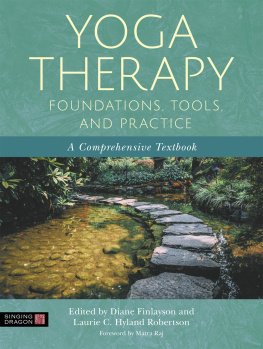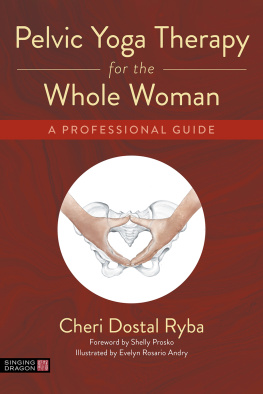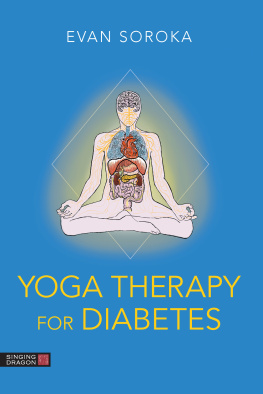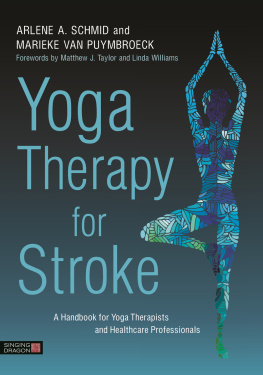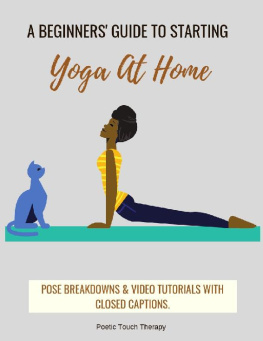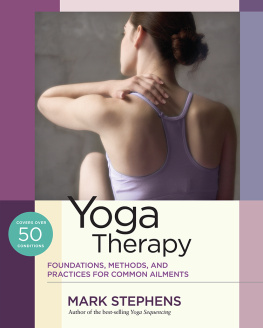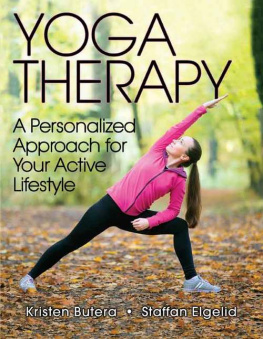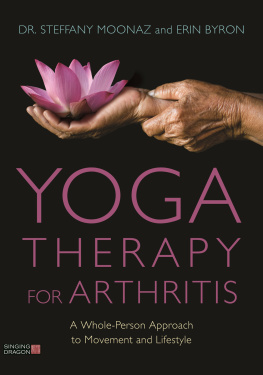Contents

YOGA
THERAPY
FOUNDATIONS, TOOLS,
AND PRACTICE
A Comprehensive Textbook
Edited by Diane Finlayson and
Laurie C. Hyland Robertson
Foreword by Matra Raj

Contents
Foreword
Yoga Therapy Foundations, Tools, and Practice: A Comprehensive Textbook not only lays down a strong theoretical foundation for yoga therapy, it also provides tools in abundance that therapists can incorporate into their practices.
Having worked in the field for over 45 years now, I can wholeheartedly recommend the topics selected by Diane Finlayson (MA, MFA) and Laurie Hyland Robertson (MS), both of whom are eminently qualified in the field of yoga therapy and its expert transmission. They have made insightful choices of material that will enhance the yoga therapists knowledge in multiple fields.
These chapters represent a stimulating and informative body of knowledge contributed by experts with diverse approaches and skill sets. This book will provoke thought and enrich the readers understanding and practice of yoga therapy in all its applications. The excellent resources listed at the end of each chapter will help to reach the depth of each subject.
The book encompasses many fundamentals and principles of the ancient holistic scriptures such as the Vedas, the Upanishads, the Bhagavad Gita , the Puranas, and ayurveda. Each of these has a universal and an individual elemental component, and an effect on the physical, emotional, and spiritual being. All emphasize the importance of the breath. Sage Patanjalis eight limbs of yoga, sutras, the Samkhya gunas , and the koshas weave through all the subject matter in the book. Sections on the Shaiva Tantra tradition of all-pervading consciousness and the energy principle of actualization by vibratory pulsation shed light on its use as a therapeutic modality that enables us to be well-balanced and at one with the universe.
Several chapters address the holistic philosophies of yoga in depth, and also the ways these philosophies can inform current practices. Yoga is increasingly recognized as a science as well as an art. It is heartening to see these bridges between quantum traditional and often-reductionist Western approaches to client care and treatment. Holism is increasingly in tune with todays understanding of the mind and body. For example, the interconnectivity of individual organ systems is now well-accepted, as is the importance of the mind in healing, in decreasing suffering and increasing wellness, and in creating inherent defenses against disease and disorder.
With greater understanding of Patanjalis sutras, a yoga therapists role may include counseling clients based on authentic ancient wisdom to gradually modify kleshas and other mental errors to address maladaptive lifestyles that can contribute to suppression or overactivity of the immune system, thus exploring the root causes of how and why an individuals illness and suffering are occurring.
Salutogenesis is the name of a current medical approach that focuses on the processes of becoming healthy, rather than on factors that cause disease. It is an apt term for the panchamaya kosha model. Patanjali points out how cognitive errors lead to fluctuation of energy or breath (prana) and prescribes a generous course of treatment based on compassion, forgiveness, selfless service, self-study, asana, breathwork (pranayama), and meditationall leading to what we might today call high emotional resilience and a high emotional intelligence quotient (EQ).
With this solid philosophical and theoretical foundation, yoga therapists can confidently apply critical thinking skills and attain research literacy in their pursuit of professional growth and development. Later chapters of the book address these needs with topics in current research relating to medicine, psychology, social factors, trauma care, inclusion, and community wellness. The client populations addressed span the years from birth and pediatrics to geriatrics and the end of life. These chapters will broaden the yoga therapists spectrum of skills and depth of understanding.
Having gone through foundations and research topics, the book concludes with a wealth of use cases that enable the yoga therapist to explore their newly acquired theoretical knowledge in the context of potential real-life situations.
This book covers a variety of approaches, traditional and non-traditional, innovative and experimental, collaborative and complementary. The clear message throughout is one of building relationships with other para-professionals. And for the yoga therapist, the advice to connect first with SELF to improve efficacy of client care is most welcome.
As a rehabilitation and yoga therapist, I strongly recommend this book to rehabilitation therapists, yoga teachers, yoga therapists, and allied professionals alike. The text will long remain a highly respected resource in the field of yoga therapy. Yoga Therapy Foundations, Tools, and Practice: A Comprehensive Textbook is a most insightful and in-depth scholarly work. Each and every chapter merits rereading again and again. I have yet to leave off reading this book without a wonderful Aha moment!
Matra Raj
The Editors, Contributors,
and Reviewers
Editors
Diane Finlayson, MA, MFA, C-IAYT
Dianes history in education and writing includes time in radio copywriting, journalism, creative writing, and running a variety of schools and programs. After 20 years of teaching courses in writing, yoga, meditation, and ayurveda for Johns Hopkins University, in her own school, and at other yoga schools and universities, she was extended the opportunity to collaborate on the development of the MS Yoga Therapy program at Maryland University of Integrative Health where she now serves as department chair.
Laurie Hyland Robertson, MS, C-IAYT, E-RYT 500
After more than a decade in healthcare and business publishing, Laurie found her way to the transformative practices of yoga and then yoga therapy. She is now editor in chief of Yoga Therapy Today and managing editor of the International Journal of Yoga Therapy , and contributes editorial services to a variety of yoga and wellness publications. Laurie divides her time between the extremes of a Costa Rican rain forest and the Baltimore-Washington area, where she owns Whole Yoga & Pilates.
Contributors
Melinda Atkins, MSc, MEd, C-IAYT, E-RYT 500
Melinda Atkins is the founding director of AUM hOMe Shala, an IAYT-accredited, Miami-based non-profit yoga school. Atkins holds a Master of Education in administration and supervision and is on track to receive a Master of Science degree from the University of Maryland School of Pharmacy. She is proud to have served more than 6,000 individuals through group classes and individual clinics since AUMs founding in 2005, and she continues to oversee all aspects of the schools operations. As a grassroots organization, AUM is funded by grants, donations, and student tuitions and bolstered by strong partnerships with local and national organizations and foundations.
Sundar Balasubramanian, PhD, C-IAYT
Dr. Sundar Balasubramanian is a cell biology researcher currently studying cellular and molecular mechanisms involved in resistance to cancer therapy at the Medical University of South Carolina. Balasubramanian is also a yoga biology researcher and certified yoga therapist. As the founder and director of PranaScience Institute, Balasubramanians yoga research has provided scientific evidence of the practices efficacy to promote well-being. His books include PranaScience: Decoding Yoga Breathing , Mind Your Breathing: The Yogis Handbook with 37 Pranayama Exercises , and Murattu Kuthiraikku 37 Kadivalangal (in Tamil). Balasubramanians work has also appeared on the TEDx stage and National Public Radio and in Discover magazine, The New York Times , and Huffington Post.

